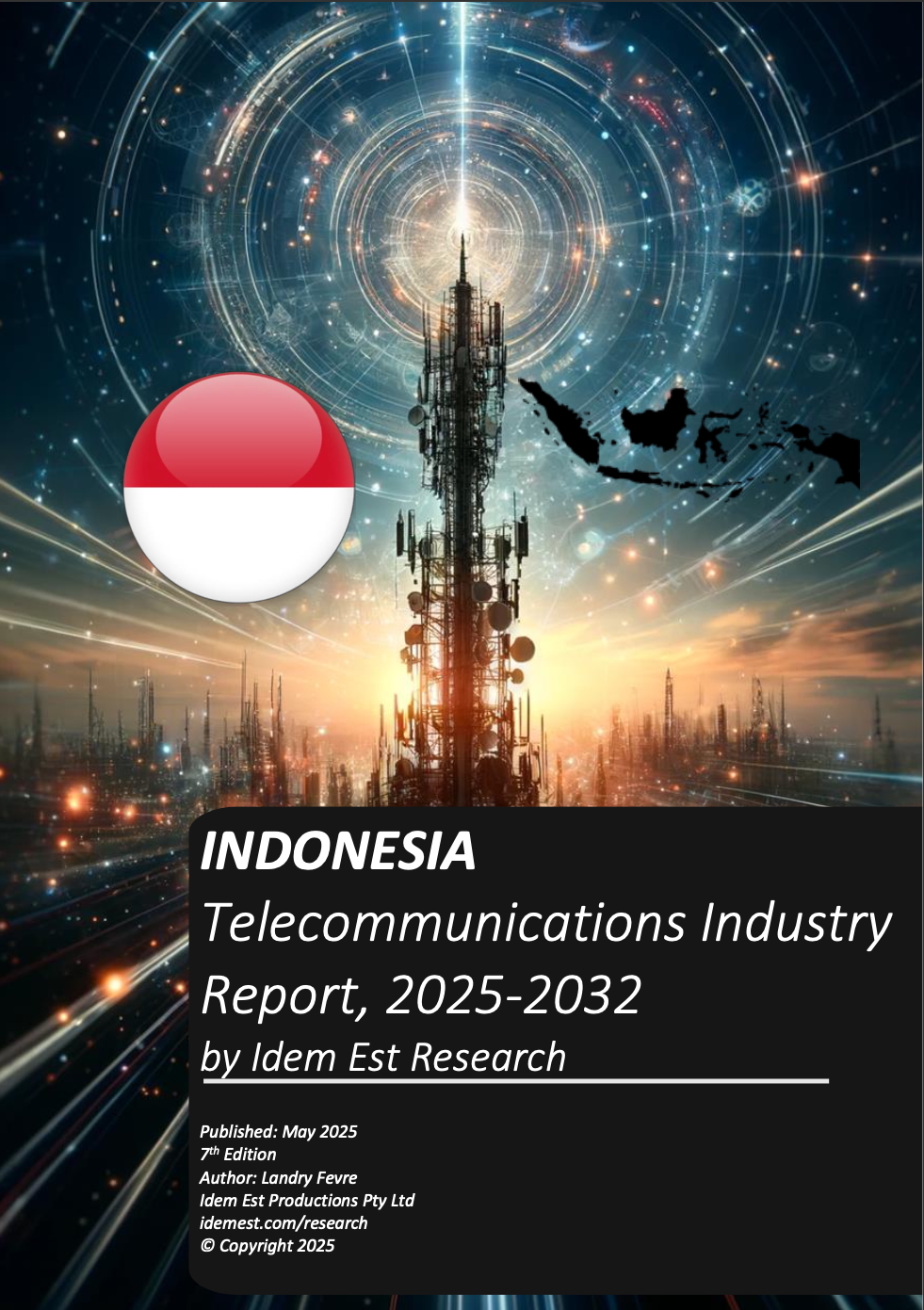Description
WHY YOU SHOULD BUY THIS INDONESIA TELECOMS INDUSTRY REPORT:
- Benefit from the latest market opportunities
- Understand the threats to your operations and investments and protect your company against future risks
- Gain insight on emerging trends that could support, strengthen or disrupt your activities in the market
- Get a full view of the competitive landscape to assess your market position.
- Forecasts as a key input for successful budgeting and strategic business planning in the telecoms market
- Target business opportunities and risks in the telecoms sector through our reviews of latest industry trends, regulatory changes and major deals, projects and investments
- Assess the activities, strategy and market position of your competitors, partners and clients via our Operators Profiles
The Indonesia Telecommunications Industry Report, 2025-2032 includes an overview of the Indonesian market dynamics, market sizing, market forecasts, analysis, insights and key trends.
EXECUTIVE SUMMARY
Indonesia Telecoms Industry Report: Key Developments, Growth Prospects, and Investment Opportunities
The Indonesia Telecoms Report 2025–2032 provides the most comprehensive and up-to-date analysis of Southeast Asia’s largest digital economy and its fast-evolving telecoms market. Spanning mobile, fixed broadband, satellite, tower, and submarine infrastructure, the report offers deep insights, reliable datasets, and strategic intelligence for investors, operators, regulators, and digital ecosystem players.
🔍 Key Themes Covered
📱 Mobile Market Transformation
-
In-depth analysis of the XL Axiata–Smartfren merger, marking the transition to a three-operator market alongside Telkomsel and Indosat Ooredoo Hutchison.
-
Subscriber and revenue forecasts to 2032, with ARPU trends, service revenue mix, and spectrum holdings by operator.
-
Competitive positioning, operator KPIs, and market share evolution across mobile, broadband, and tower markets.
🌐 Fixed & Satellite Broadband
-
Broadband subscribers forecast to reach 29 million by 2032, with household penetration rising to 35%.
-
Profiles of key players: Telkom Indonesia, XL Home/Link Net, MyRepublic, Icon+, Moratelindo, and Starlink.
-
Satellite broadband users set to exceed 3 million by 2032, fuelled by new entrants and LEO constellations.
🛰️ Spectrum & Infrastructure Intelligence
-
Comprehensive spectrum allocation benchmarking across 850–2300 MHz bands and subscriptions per MHz by country.
-
Indonesia’s spectrum scarcity compared regionally with high subscribers-per-MHz ratio, pressuring network quality and investment cycles.
🗼 Tower Market Landscape
-
Detailed tower and tenancy data covering 126,000 towers, with operator KPIs for Mitratel, Tower Bersama, Protelindo, Centratama/Edgepoint, and more.
-
Insights on tower consolidation trends, tenancy ratios, average revenue per tower, and site decommissioning risks post-operator M&A.
🌍 International Infrastructure & Cross-Border Connectivity
-
Full submarine cable map and database of over 20 active and planned systems, including SEA-ME-WE, Bifrost, Apricot, Echo, and SJC.
-
Review of IXP throughput, international bandwidth, and internet backbone capacity benchmarks across 39 European and Asia-Pacific markets.
🛠️ 5G, NTN, & Satellite Disruption
-
Strategic profiles of Starlink, AST SpaceMobile, Lynk, Kuiper, and others entering the NTN/5G direct-to-device space.
-
Indonesia’s role in global LEO infrastructure as satellite broadband supplements rural 5G and fiber gaps.
🔁 M&A and Diversification Outlook
-
Evaluation of telco-driven diversification into fintech, logistics, e-commerce, and data centre infrastructure.
-
Strategic investments from Telkomsel in GoTo (Tokopedia + Gojek), and LinkAja’s role in digital financial services.
📊 Deliverables
-
PDF report with 100+ pages of market analysis
-
Datasets with operator-level KPIs
-
Maps and visualisations: tower share, spectrum, submarine cables, broadband forecasts
-
Forecasts to 2032 with CAGR calculations and scenario-based outlook
📈 Why This Report?
Indonesia is undergoing a once-in-a-decade telecom reset, with consolidation, 5G rollout delays, spectrum constraints, and pressure on ARPU defining the industry. This report offers:
-
Independent, data-backed insights trusted by investors and regulators
-
Coverage of all major players and infrastructure segments
-
Tailored insights for strategic planning, market entry, and due diligence
Indonesia Telecoms Industry Report – TABLE OF CONTENTS
1 Key Statistics
1.1 Indonesia’s Population
1.2 Indonesia’s Economy
1.3 Indonesia’s GDP
2 Overall Telecommunications Market, 2018–2032
2.1 Market Overview
2.2 Historical Telecommunications Market Revenue, 2018-2032
2.3 Overall Telecommunications Market Forecast, 2024-2032
2.4 Telecommunications Market Capital Expenditure, 2018-2032
2.4.1 Historical Telecommunications Capex Spend, 2018-2024
2.4.2 Capex to Revenue Benchmark
2.4.3 Capex to GDP Benchmark
2.4.4 Telecommunications Capex Spend Forecast, 2024-2032
3 Telecommunications Operators Profile
3.1 Telkom Indonesia Profile
3.1.1 Telkom Revenue and EBITDA Mix
3.1.2 Telkomsel
3.2 Indosat Ooredoo Hutchison Profile
3.2.1 IOH Revenue and EBITDA Mix
3.2.2 Tri Indonesia (Historical Only)
3.2.3 Tri Indonesia Revenue and EBITDA Mix
3.3 XL Axiata
3.3.1 XL Axiata Revenue and EBITDA Mix
3.3.2 Link Net
3.3.3 Link Net Revenue, EBITDA and Capex Mix
3.4 Smartfren Profile
3.4.1 Smartfren Revenue, EBITDA and Capex Mix
3.5 Other Players Profile
3.5.1 MNC Vision
3.5.2 BizNet
3.5.1 Icon+
4 Mobile Market
4.1 Mobile Subscribers Historical and Forecast, 2018-2032
4.1.1 Mobile Subscribers Historical, 2018-2024
4.1.2 Mobile Subscribers Market Share, 2018-2024
4.1.3 Indonesia Smartphone Share, 2025
4.1.4 Mobile Subscribers Forecast, 2024-2032
4.1.5 Indonesia Mobile Subscribers by Generation (2G, 3G, 4G & 5G) Forecast, 2024-2032
4.2 Mobile Revenue Historical and Forecast, 2018-2032
4.2.1 Historical Mobile Revenue, 2018-2024
4.2.2 Mobile Revenue Market Share, 2018-2024
4.2.3 Mobile Revenue Forecast, 2024–2032
4.2.4 Mobile Subscribers ARPU, 2018-2024
4.3 Spectrum Holdings
4.3.1 5G Development and Launches
4.3.2 Mobile Frequencies Portfolios Analysis
4.3.3 Spectrum Depth Benchmark by Country
4.4 Asia Pacific Mobile Download Data and Pricing Benchmark – 2025
4.5 Mobile Speed Tests
4.5.1 Ookla Mobile Speed Tests
4.5.2 OpenSignal
5 Broadband Market
5.1 Fixed Broadband Subscribers Historical, 2018-2024
5.2 Fixed Broadband Subscribers Forecast, 2024-2032
6 Satellite Internet Connectivity
6.1 Comparing LEO, MEO, and GEO Satellite Orbits
6.1.1 LEO and GEO Satellite Comparison
6.2 Satellite Broadband Providers Operators, 2025
6.3 5G NTN: The Next Generation of Satellite Connectivity
6.3.1 5G NTN Overview
6.3.2 The Rationale Behind 5G NTN
6.3.3 Technical Aspects of 5G NTN
6.3.4 Potential Applications for 5G NTN
6.3.5 Challenges in Implementation
6.3.6 5G NTN Satellite Providers
6.4 Satellite Internet Market Analysis, 2024-2032
6.4.1 Market Landscape of Satellite Broadband Subscribers, 2025
6.5 Indonesia Satellite Broadband Subscribers Forecast, 2024-2032
7 Fixed Telecommunications Infrastructure Investments
7.1 Fixed Digital Infrastructure
7.1.1 Palapa Ring Completed
7.1.2 FTTH – 20m premises to go
7.1.3 Submarine Cables
8 Indonesia Telecom Towers Infrastructure Landscape
8.1 Indonesia Telecom Towers Market Analysis, 2025
8.1.1 Indonesia Telecom Towers Market Overview
8.1.2 Indonesia Telecom Towers Background
8.2 Indonesia Tower Market Competitive Landscape Comparison
8.3 Indonesia Telecom Towers & Rooftops Market Forecast
8.3.1 Indonesia Telecom Towers and Rooftops, Revenue, Penetration Forecast, 2024-2032
8.4 Mitratel Profile
8.4.1 Mitratel Revenue, EBITDA and Towers, 2018 – 2024
8.5 Tower bersama Profile
8.5.1 Tower Bersama Revenue, EBITDA and Towers, 2018 – 2024
8.6 Protelindo Profile
8.6.1 Protelindo Revenue, EBITDA and Towers, 2018 – 2024
8.7 Centratama Menara Profile
8.7.1 Centratama Menara Revenue, EBITDA and Tower Statistics, 2018 – 2024
8.8 Tower Density Benchmark
9 Thematics / Opportunities
9.1 Consolidation Opportunities
9.2 Diversification Opportunities
9.3 6G on the Horizon
10 Telco Transaction Database
11 Methodology
12 Copyright Notice
Indonesia Telecoms Industry Report – List of Figures
Figure 1 – Telco sector revenue as % of GDP in Indonesia
Figure 2 –Revenue Profile Historical Mix (IDR bn), 2018 – 2024
Figure 3 – Telecommunications Market Revenue, 2024
Figure 4 – Telecommunications Market EBITDA, 2024
Figure 5 – Telecommunications Revenue & EBITDA Share, 2024
Figure 6 – Total Telecoms Market Revenue and Growth Rate (IDR tn), 2024-2032
Figure 7 – Capex to Revenue Benchmark, 2018-2024
Figure 8 – Capex to GDP Ratio Benchmark, 2018-2024
Figure 9 – Telecommunications Capital & Operational Expenditure Spend, 2000-2032
Figure 10 – Telkom Indonesia Revenue Mix – 2018-2024
Figure 11 – Telkom Indonesia Historical Revenue Mix, 2018 – 2024 (IDR bn)
Figure 12 – Telkomsel Revenue Mix – 2018-2024
Figure 13 – Telkomsel Historical Revenue Mix, 2018 – 2024 (IDR bn)
Figure 14 – IOH Revenue Mix – 2018-2024
Figure 15 – IOH Historical Revenue Mix, 2018 – 2024 (IDR bn)
Figure 16 – Tri Indonesia Revenue Profile (IDR bn) and EBITDA Margin (%), 2015-2021
Figure 17 – XL Axiata Revenue Profile (IDR bn) and EBITDA Margin (%), 2018-2024
Figure 18 – Link Net Revenue Profile (IDR bn) and EBITDA Margin (%), 2018-2024
Figure 19 – Smartfren Revenue Profile (IDR bn) and EBITDA Margin (%), 2018-2024
Figure 20 – Mobile Subscribers Share Comparison, 2018-2024
Figure 21 – Mobile Subscriber Share Comparison, 2018-2024
Figure 22 – Mobile Net Adds (000’s) Comparison, 2018-2024
Figure 23 – Mobile Subscribers Forecast, 2018-2032
Figure 24 – Indonesia Mobile Subscribers by Generation (2G, 4G & 5G) Forecast, 2024-2032
Figure 25 – Mobile Revenue Share Comparison, 2018-2024
Figure 26 – Mobile Service Revenue Forecast (IDR trillion), 2024-2032
Figure 27 – Mobile Subscribers ARPU, 2018-2032
Figure 28 – Subscriptions per MHz of Spectrum, Select Asia-Pacific Countries, 2025
Figure 29 – Asia Pacific Data Pricing Benchmark, 2025
Figure 30 – Broadband Subscribers Share Comparison, 2018-2024
Figure 31 – Indonesia Net-Adds (000’s) by Operators, 2018-2024
Figure 32 – Broadband Subscribers Forecast, 2024-2032
Figure 33 – Satellite Deployments Type
Figure 34 –Starlink and OneWeb Satellite Launches per Month (Data until Feb-25)
Figure 35 –Indonesia Satellite Broadband Market Share, 2025
Figure 36 – Indonesia Satellite Broadband Subscribers (k) Forecast, 2024-2032
Figure 37 – Indonesia Telecom Towers Market Share, 2024
Figure 38 – Indonesia Telecom Towers Forecast, 2024-2032
Figure 39 – Subscribers per Tower, 2025
Indonesia Telecoms Industry Report – List of Tables
Table 1 – Indonesia – Key Statistics
Table 2 – Telecommunications Market Revenue by Operators, 2018-2024
Table 3 – Total Telecommunications Market Revenue, 2024-2032
Table 4 – Historical Telecommunications Capex Spend, 2018-2024
Table 5 – Total Telecommunications Capex Investments Forecast, 2024-2032
Table 6 – Historical Telkom Revenue & EBITDA, 2018-2024
Table 7 – Telkomsel Revenue & EBITDA, 2018-2024
Table 8 – IOH Revenue and EBITDA Mix, 2018-2024
Table 9 – Tri Indonesia Revenue and EBITDA Mix, 2015-2021
Table 10 – XL Axiata Revenue and EBITDA Mix, 2018-2024
Table 11 – Link Net Revenue Segments, 2018-2024
Table 12 – Smartfren Revenue and EBITDA Mix, 2018-2024
Table 13 – Historical Mobile Subscribers, 2018-2024
Table 14 –Indonesia Mobile Subscribers Forecast, 2024-2032
Table 15 – Indonesia Mobile Subscribers by Generation (2G, 4G & 5G) Forecast, 2024-2032
Table 16 – Historical Mobile Service Revenue, 2018-2024
Table 17 – Indonesia Mobile Service Revenue Forecast, 2024-2032
Table 18 – Historical Mobile ARPU, 2017-2023
Table 19 – Spectrum Holdings by Operators and by Bands (MHz)
Table 20 – Mobile Frequencies by Operators and by Band (MHz)
Table 21 – Historical Broadband Subscribers, 2018-2024
Table 22 – Historical Broadband ARPU, 2018-2024
Table 23 – Indonesia Broadband Subscribers Forecast, 2024-2032
Table 24 – Satellite Orbit Altitudes
Table 25 – LEO and GEO Satellite Comparison
Table 26 – Satellite Broadband Subscribers Operators, 2025
Table 27 – 5G NTN and Satellite Providers, 2025
Table 28 – Indonesia Satellite Broadband Subscribers Forecast, 2024-2032
Table 29 – International Submarine Cable Systems with Landing Stations in Indonesia
Table 30 – Indonesia Telecom Towers Market Analysis, 2024
Table 31 – Indonesia Telecom Towers Indicative Tower Leasing Annual Fees
Table 32 – Indonesia Telecom Towers Transaction Database, 2008-2025
Table 33 – Indonesia Telecom Towers and Rooftops, Revenue, Mobile Subscribers, Penetration & ARPU Forecast, 2024-2032
Table 34 – Historical Mitratel Revenue, EBITDA and Tower Statistics, 2018-2024
Table 35 – Historical Tower Bersama Revenue, EBITDA and Tower Statistics, 2018-2024
Table 36 – Historical Protelindo Revenue, EBITDA and Tower Statistics, 2018-2024
Table 37 – Historical Centratama Menara Revenue, EBITDA and Tower Statistics, 2018-2024
Table 38 – Telco Transaction Database, 2008-2025
KEY COMPANIES MENTIONED IN THIS INDONESIA TELECOMS INDUSTRY REPORT:
BizNet, Centratama, CyberIndo, DigitalBridge, EdgePoint, Faznet, FiberStar, Gihon, GoJek, Icon+, IndiHome, Indosat, Kabel MNC Play, Link Net, Mitratel, MyRepublic, Protelindo, Smartfren, Starlink, Telkom, Telkomsel, Tokopedia, Tower Bersama, Tri Indonesia, XL Axiata.
Other Idem Est Research Telecoms Country Reports
Australia, Bangladesh, China, India, Indonesia, Japan, New Zealand, Malaysia, Myanmar, Pakistan, Philippines, Singapore, South Korea, Taiwan, Thailand, Vietnam,
Asia Pacific Telecom Towers, Starlink Company Profile






